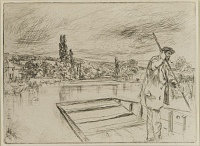The Punt | ||
| Number: | 82 | |
| Date: | 1861 | |
| Medium: | etching and drypoint | |
| Size: | 120 x 166 mm | |
| Signed: | 'Whistler' at lower left (1-3); 'W' partly removed (4-final) | |
| Inscribed: | '1861.' at lower left (1-3); partly removed (4-final) | |
| Set/Publication: | Junior Etching Club, 1862 | |
| No. of States: | 6 | |
| Known impressions: | 35 | |
| Catalogues: | K.85; M.86; T.85; W.68 | |
| Impressions taken from this plate (35) | ||
KEYWORD
illustration, landscape, man, punt, river.
TITLE
It has mainly been known by one title, but not the original title, as seen in the following examples:
'The Angler' (1862, Passages from Modern English Poets). 1
'The Punt' (1874, Ralph Thomas, Jr (1840-1876)). 2
'The Punt' (1881, Union League Club). 3
'The Punt' (1886, Frederick Wedmore (1844-1921)). 4
This is an odd situation: the original title is based on J.H. Reynold's poem, 'The Angler's Soliloquy', which Whistler supposedly illustrated, but the etching is dominated completely by a punt. Not surprisingly, later cataloguers opted for the descriptive title, 'The Punt', as does this catalogue.
'The Angler' (1862, Passages from Modern English Poets). 1
'The Punt' (1874, Ralph Thomas, Jr (1840-1876)). 2
'The Punt' (1881, Union League Club). 3
'The Punt' (1886, Frederick Wedmore (1844-1921)). 4
This is an odd situation: the original title is based on J.H. Reynold's poem, 'The Angler's Soliloquy', which Whistler supposedly illustrated, but the etching is dominated completely by a punt. Not surprisingly, later cataloguers opted for the descriptive title, 'The Punt', as does this catalogue.
1: Illustration to J.H. Reynolds's 'The Angler's Soliloquy', Passages from Modern English Poets, London, [1862].
2: Thomas 1874[more] (cat. no. 85).
3: New York 1881 (cat. no. 96).
4: Wedmore 1886 A[more] (cat. no. 68).
DESCRIPTION
A river scene, drawn from a punt, of which only the stern is visible. The boatman is in the right hand corner, his pole angled sharply downwards to right. He has a pipe in his mouth, and wears a low-crowned soft hat, and a loose coat and trousers, possibly of white linen. In the distance is another punt on the river, the wooded river-bank and rolling country under a cloudy sky.
SITTER
The boatman has not been identified, but could be one of Whistler's friends, such as Edwin Edwards (1823-1879), or Matthew White Ridley (1837-1888), who sometimes accompanied Whistler on excursions into the country. Ridley is the subject of The Guitar Player (M.W. Ridley) 124.
SITE
This may have been etched on a visit to Edwin Edwards at Sunbury-on-Thames. Mansfield described it as 'A scene on the upper Thames.' 5 Lochnan points out:
5: Mansfield 1909[more] (cat. no. 85).
'Mansfield, who may have had an opportunity to consult Haden or Mrs Edwards on the order of these plates, interspersed The Punt and Landscape with Fisherman with plates which appear to have been made at Sunbury. His order is as follows: Encamping, M. 82, The Storm¸ M. 83, Landscape with Fisherman, M. 84, Sketching No. 2, M. 85, The Punt, M. 86, and Sketching No. 1, M. 87. It is not possible to say that any of these plates with the exception of Encamping was made at Sunbury, but it seems very likely that they were.' 6
6: Lochnan 1984[more], chap. 7, n. 15.
DISCUSSION

At first glance this etching does not seem an appropriate illustration for J.H. Reynolds's poem 'The Angler's Soliloquy', compared to two related etchings, Sketching, No. 2 084 and Landscape with Fisherman 085, which both show anglers. It is possible these were ideas for the illustration but that they were rejected. The first, ilustrated above, was probably too big, and is throughly cancelled.

The other, illustrated here, exists in only a single impression, probably a proof, and it is not clear why it was unsatisfactory, apart from the fact that it is almost a mirror image of Whistler's other illustration for Passages from Modern English Poets, Sketching 083, which was used to illustrate Charles Mackay's poem 'A River Scene'.
This left Whistler and the publishers with The Punt as the only marginally relevant illustration for Reynolds's poem.
Punting - propelling a flat-bottomed boat by using a pole - was a popular pastime on the calmer reaches of the Thames and other shallow southern British rivers and was also a mode of transport used by fishermen and hunters. 7
7: See George D. Leslie, RA, Our River, London, 1881, pp. 222-41.
